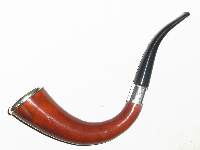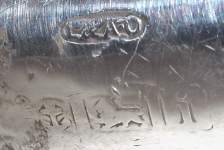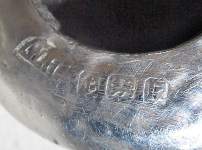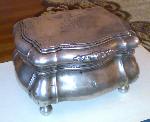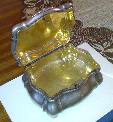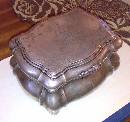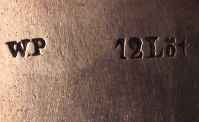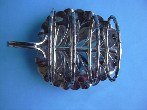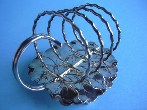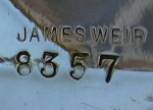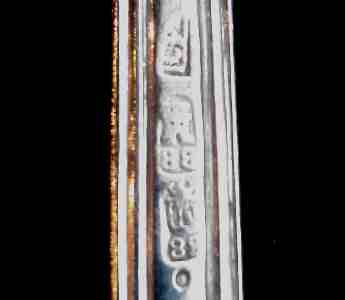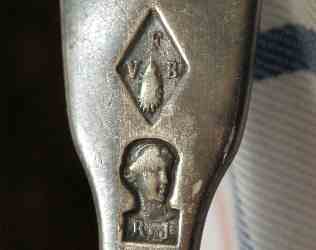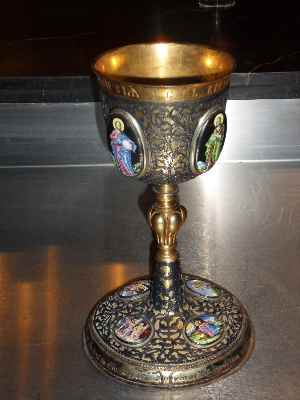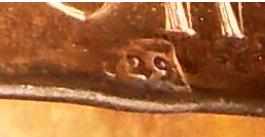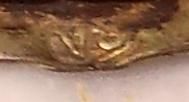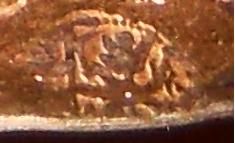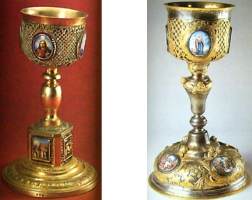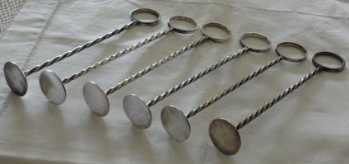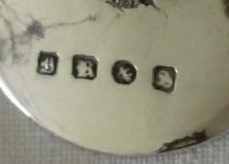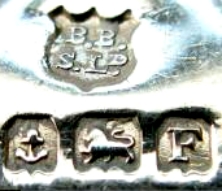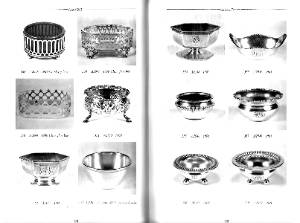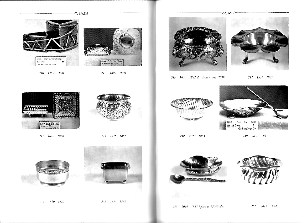This month ASCAS celebrates
its sixth anniversary. A happy ocurrence with a little
regret.
For the first time in its existence, ASCAS newsletter is
published without its monthly column "MEMBERS' WINDOW".
The reason of this absence is obvious: the "store" of
material suitable for publication in this column is
empty and no new article was proposed this month by
ASCAS members.
In the past, in similar occurrences, I wrote something suitable for publication in this
column.
This month I did not as I would prefer that this
continues to be the ASCAS Newsletter and not
Giorgio Newsletter. I realize that the newsletter
and its columns are already overcrowded and abundantly
supplied with my writings (answers to questions, "a book
on my shelf", "a word per month", "a page per month", "a
silversmith per month", "a crest per month", etc. and
other external contributions are desirable and necessary.
My appeal for aid is to the mass of potential authors
who could contribute to the ASCAS newsletter writing about
their small or large collection and sharing with others
(anonymously if necessary) their knowledge, their
passion and their researches.
My thanks to Christophe, David, Dorothea, Jayne,
Giovanni, Lazar, Piero, Postnikov, Robert... and to the
many other authors, not listed here, who
were also an indispensable support to my work. I am proud
to affirm, that they have made a decisive contribution to the ASCAS success in
these six years.
Happy birthday ASCAS.
Giorgio Busetto
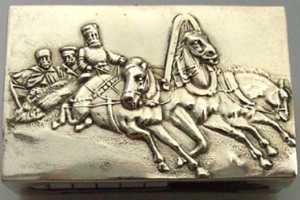
"Postnikov"
presents:
Russian Matchbox Holders 
.....There were several important centers of
gold and silver work in Russia but I will focus
mainly on Moscow (Moscow work tended to consist
of traditional Russian design) and St.
Petersburg (St. Petersburg silversmiths
developed a new style that had a western
orientation yet retained Russian characteristics).
From about 1830 until 1917, Russian aristocrats
favoured English design (especially in match
safes) and Russian silver work showed evidence
of that liking. The idea of combining European
art with Russian technical genius produced great
pieces. What was en vogue in European countries
was adopted at once but altered in the Russian
way: larger dimensions, a high level of
workmanship, and more expensive than the
European models they were inspired by......
click here 
|
Welcome to new ASCAS members:
Joel Abramowitz - USA
Kathleen White Koehrsen - USA
Marwan Khoury - Lebanon
Irving J. Meyerson - USA
Fred Newman - England UK
Alan Shearman - England UK
Hope Stubbs - Canada
Jennifer Stubbs - Canada
Piero Eduardo writes:
...I need information about this pipe bearing two silver
hallmarks:
Assay Office Birmingham 1908, L & A.O into a oval -
Louis ORLIK Alfred ORLIK trading as L&A ORLIK - London
and another: W.H , possibly William Hannay, Glasgow 19th
c./1st half or W.H into an oval, possibly W M Hayes, end
19th c./beginning 20th c.
I'm wondering why there are two different hallmarks and
different date letters?
Your help will be greatly appreciated
Piero Eduardo
The W.H mark belongs to William Harrison, London,
but his marks were entered by Imperial Tobacco Co. In my
opinion the pipe was mounted by (or in the interest of)
Imperial Tobacco Co using silver mounting supplied by
specialized manufacturers.
Obviously, this is only a hypothesis and your question
needs an answer by someone with a deeper knowledge of
pipes.
Giorgio Busetto
Tom Baronas writes:
...I have a silver casket and I'm unable to identify the
master mark and year of manufacture. Its weight is 400
gr. and measures 15x12x9 cm.
Can you help me?
Tom Baronas
The casket is marked 12 Lot, corresponding to
silver fineness 750/1000. Lot was used in German areas
before c.1890 but I'm unable to identify the maker.
Any suggestion will be appreciated
Giorgio Busetto
Shirley Nesbitt writes:
...I am so interested in tracking down a Silversmith &
Retailer JAMES WEIR and find out when he operated.
I believe he was a Glasgow Silversmith and Retailer.
I have a Silverplated Toastrack in the shape of a
stylised leaf (looks rather 'Arts and craft' style) ....
I am assuming it is not silver as I cannot find a
Hallmark on it, although it looks like 'silver' quality.
The mark on the Toastrack is :- JAMES WEIR 8357 (also
scratched on free hand the following: - ' 467 R/A' (the
R/A is crossed through) also N/A and an asterisk of
sorts). I wondered if the number was a style or
Registration Number and where I would find a list of
Registration Numbers for Silverplate?
I would be very grateful for any light you may be able
to shed on this Toastrack mystery!
Many thanks,
Shirley
I found little information about James Weir,
Jewellers & silversmiths, Buchanan Street, Glasgow. J
Weir Ltd after c1920. Weir registered sterling silver
marks at Glasgow Assay Office between the end of 19th
century and the beginning of 20th century.
The number is, probably, the model number of your item.
Obviously it's silver plate and not sterling silver.
Any further information will be welcome.
Giorgio Busetto
Replies to questions
Christophe Ginter writes:
The "mysterious" mark may be French, but the
master with initials FVB is unknown to me at first
glance. Probably a maker in the province, first quarter
20th century.
The female head is, from my point of view, some kind of
"family armorial", dedication to a woman.
Some years ago, I had a dinner in a northern town in
France, and the service was struck with such a head and
I was informed that it was a grandmother of this family.
RJ would be her initials.
Christophe
Postnikov writes:
A Russian chalice with 8 "Finifts" (painted
enamel plaques), silver/niello, gilded.
Chronicles from the Ipatjev monastery recorded the
existence of Russian Enamels as early as 1175. In those
days coloured enamels were valued because of their
exquisite beauty and very high prices were paid for them.
The production technique was borrowed from Byzantium but
as time went on, the art of enamelling acquired
traditionally Russian features. The name of the
technique came from the Greek word "fingitis" (i.e.
white stone), then it changed to "finipt" and then to "finift".
The old Russian town of Rostov has always been famous
for this artistic tradition.
The marks are (top to bottom):
year: 1729
maker: Vasilij Lukin
town mark: Moscow 1729-1733, assayer: Afanasi Rybakov
Without better, less blurry photos I can give no better
answers.
Postnikov
Here are the images of two similar chalices
Simon Buxton writes:
The 6 twist stem items in March issue are indeed
sugar crushers. I have one or two in Old Sheffield Plate
dating to around the 1790s. It is possible those shown
date to the early 1800s since I think they were never
used much later, such as after the introduction of
electroplating. The marks suggest close plating (silver
foil on steel) which superseded the old Sheffield plate
process for cutlery due to its greater strength. Its
grey colour where worn or a simple test with a magnet or
compass should confirm this.
Regards
Simon
In this column we present a
page obtained from makers' brochures, books, auction
catalogs, advertising or whatever other printed paper,
related to silver, that may be of interest for ASCAS
members.
The images will be published at a "low resolution" level
and for private and personal use only
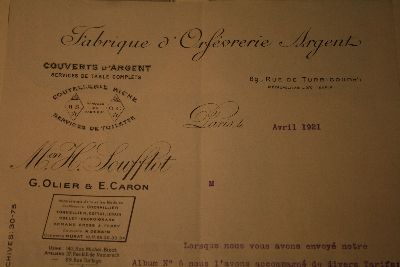
|
This month Pietro Fantazzini presents a 1921
letterhead used by the French (Paris) "Fabrique
d'Orfevrerie Argent H. Soufflot - G. Olier & E.
Caron"
Mon H. SOUFFLOT
G. OLIER & E. CARON
Usine: 143 Rue Michel-Bizot
Ateliers: 37 Rue N.D. de Nazareth
89 Rue Turbigo
The firm notes its ownership of the
patterns designed by CHENAILLIER, TONNELLIER,
COTTAT, LENAIN, COLLET-ESCROIGNARD, ARMAND GROSS
& FERRY, A.DEBAIN, MURAT.
|
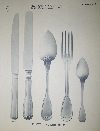
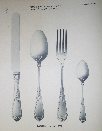
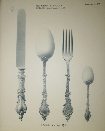

|
Henry Soufflot was active with the mark "HS,
sun and star" from 1884 to 1910 (89 Rue de
Turbigo).
Another mark was entered by Soufflot & Cie in
1910 (from May 25 until November 9, 1910). On
November 15, 1910 Olier & Caron entered a
similar mark using the initials OC (possibly
this mark was cancelled in 1936).
This letter (dated 1921) is signed by G.Olier &
E.Caron and bears on the letterhead both marks (the
ancient HS and OC). It accompanied a flatware
catalog sent to ditta (firm) Giuseppe Menzani of
Bologna (Italy). The firm, owned and managed by
Pietro Fantazzini's family (the founder was his
grandfather), is still active in the present days
and continues to trade gold and silver jewelry
in its Bologna shop.
|
"A WORD per MONTH"
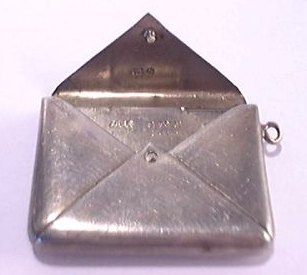
|
STAMP CASE
The silver stamp cases began to be produced
toward the end of 19th century using gold,
silver and wood. Some of the earliest British
stamp boxes date from the 1880s, when the silver
stamp case came into regular production. In
1888, James Allen of Birmingham registered a
pocket letter scales/stamp holder, which he made
in silver and brass. Production of stamp cases
offered a wide array of combinations with one,
two, three and occasionally four different
compartments...
more
|
"A SILVERSMITH per MONTH"
|
|
BARKER BROTHERS
BARKER BROTHERS SILVERSMITHS LTD
BARKER ELLIS SILVER CO
Business
established in Birmingham in 1801. The firm
still possesses the original Boulton & Watt dies
acquired during its early days of manufacturing.
The business appears in an 1871 directory as
Barker Brothers, silversmiths active in Paradise
Street. As Barker Brothers Silversmiths Ltd, it
was incorporated in 1907....
more
|
"A BOOK ON MY SHELF"
In this column we present
books, new or ancient, dealing with silver in all its
aspects (history, marks, oddities...). This isn't a
"book review" but only a fair presentation of some
useful "tools" that anyone may have in the shelf of his
bookcase.
ASCAS members are invited to contribute to this column
(click to enlarge images)
The "book on my shelf" of this month presents:
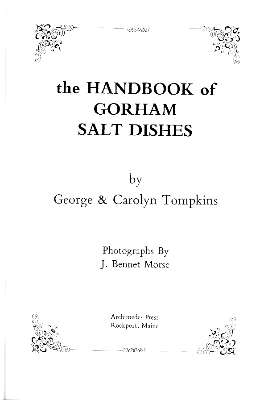
|
This is what the
authors wrote in their "Introduction" of the
book:
Carolyn Tompkins began collecting little
inexpensive salt dips, or open salts, in October
of 1971. When her collection had grown to more
than 1,800 different examples of various
materials she realized that the specialization
was necessary, so in 1980 she decided to
concentrate on salt dishes made by Gorham (because
George Tomkins was Manager of Data Processing
for that company from 1970 until his retirement
in 1978). At that time there were thirty-five
Gorham salts in her collection, and George
joined Carolyn in the pursuit of Gorham
specimens. By frequenting flea markets, antique
shops, antique shows, and through the good
offices of many cooperative antique dealers and
friends, the collection has grown to the present
size of three hundred fifty plus, and is
continuing to grow....
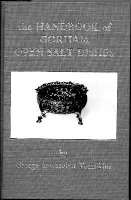
|
"A CREST per MONTH"
In this column we present
images and descriptions of Crests and Mottoes of British,
Irish and Scottish families as engraved on silver items.
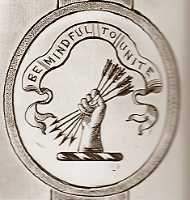
|
BRODIE
JAMES-CAMPBELL, Esq.
of Lethen and Coulmony, Nairn.
A dexter hand with a bunch of arrows
Motto: Be mindful to unite
The crest is engraved on a pair of tea canisters,
hallmarked London 1770, silversmiths John Parker
I and Edward Wakelin
|
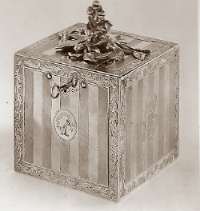 |
Closing our April 2010 edition of
ASCAS Newsletter I hope you have appreciated its content.
Your comments, suggestions and advice will be of great
help.
My thanks to Bryan
Abbott, Tyr Baudouin-Lowet de Wotrenge, Charles C. Cage,
Paola Continella, Sara Dilewski, Jayne Dye, Pietro
Fantazzini, Mario Galasso, Johanna Gehrlein, Christophe
Ginter, Ilsiya Gloova, Fritz Guercke, Jolyon Warwick
James, Darren Marais, Carolyn Meacham, Josť Luis MuŮoz,
Caroline Padavano, Postnikov, Luigi Speziale, John Yale
for their invaluable contributions.
Giorgio Busetto
Secretary
DISCLAIMER AND PRIVACY POLICY
ASCAS is a community of people having a
common interest in antique silver.
It is a non-profit association without
commercial links. Membership is open to whomever
has a true interest in this subject matter.
ASCAS has no real property and no fees are
requested nor accepted from members.
ASCAS keeps in touch with its members only
through periodical newsletters, e-mails and
web-site updating and ignores and is not
responsible for any other activity pursued by
its members.
Likewise, ASCAS is not responsible for opinions,
evaluation and images displayed, and in any form
published or supplied for publication, by its
members who, in any case, maintain the property
of their works and assure the respect of
national and international legislation about
Intellectual Property.
ASCAS does not have the full addresses of its
members (only town, country and e-mail address
are requested for membership).
ASCAS handles and protects with care its members'
e-mail addresses, will not disclose the
addresses to third parties, will use this
information only to reply to requests received
from members and for communications strictly
related to its activity.
These rules are expressly accepted by submitting
the membership request.
|
|
 newsletter
# 71 APRIL 2010
newsletter
# 71 APRIL 2010




